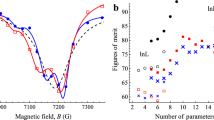Play all audios:

ABSTRACT MANY recent authors of texts containing an account of the historical development of the numerical value of π write under the misapprehension that in the Old Testament its apparent
value is 3. Concerning this value, Prof. E. T. Bell writes1: “This approximation to π is famous for its occurrence in the Old Testament”. Quoting 2 Chron. 4, 2, Prof. L. Hogben deduces2 “The
ancient Hebrews were content with taking π as 3”. The late Prof. G. H. Hardy could scarcely have examined his two quotations, otherwise he would not have made the blunt observation3: “It is
stated in the Bible that π = 3”. P. Ehibreil quotes4 1 Kings 7, 23, and contrasts the approximation with Shanks's value of π to 707 decimal places. Quoting 2 Chron. 4, 2, Prof. T.
Dantzig comments5 that this description indicates that the Jews held that π is equal to three. Very recently, Archbold quotes6 Dubreil that the Bible gives the value of π as 3, thereby
perpetuating the error in the minds of the next generation of students who read his text. These writers therefore fall into two classes, the first regarding π as actually given by 3, and the
second regarding the measurements given as only approximate. Even some Biblical commentators have fallen into similar error; for example, Curtis and Madsen in their commentary7 on 2 Chron.
4, 2 suggest that the numbers are only approximations. Access through your institution Buy or subscribe This is a preview of subscription content, access via your institution ACCESS OPTIONS
Access through your institution Subscribe to this journal Receive 51 print issues and online access $199.00 per year only $3.90 per issue Learn more Buy this article * Purchase on
SpringerLink * Instant access to full article PDF Buy now Prices may be subject to local taxes which are calculated during checkout ADDITIONAL ACCESS OPTIONS: * Log in * Learn about
institutional subscriptions * Read our FAQs * Contact customer support SIMILAR CONTENT BEING VIEWED BY OTHERS EASY COMPUTATION OF THE BAYES FACTOR TO FULLY QUANTIFY OCCAM’S RAZOR IN
LEAST-SQUARES FITTING AND TO GUIDE ACTIONS Article Open access 19 January 2022 FROM SOCIOLOGY OF QUANTIFICATION TO ETHICS OF QUANTIFICATION Article Open access 19 August 2020 PHYSICAL
INTERPRETATION OF ENTROPY, BOLTZMANN CONSTANT, AND TEMPERATURE Article Open access 31 July 2024 REFERENCES * Bell, E. T., _“The Development of Mathematics”_, 40 (McGraw-Hill, New York,
1945). Google Scholar * Hogben, L., _“Mathematics for the Million”_, 251 (Allen and Unwin, London, 1940). MATH Google Scholar * Hardy, G. H., _“A Course of Pure Mathematics”_, 70
(Cambridge, 1952). Google Scholar * Dubreil, P., _“Les Grands Courants de la Pensée Mathématique”_, edit. by le Lionnais, F., 99 (Cahiers du Sud, 1948). Google Scholar * Dantzig, T.,
_“Number, the Language of Science”_, 113 (Allen and Unwin, London, 1947). Google Scholar * Archbold, J. W., _“Algebra”_, 5 (Pitman, London, 1958). Google Scholar * Curtis, E. L., and
Madsen, A. A., _“The International Critical Commentary; The Books of Chronicles”_, 331 (Clark, Edinburgh, 1910). Google Scholar * Smith, W., _“A Dictionary of the Bible”_, 3, 1172 (Murray,
London, 1893). Google Scholar * Montgomery, J. A., and Gehman, H. S., _“The International Critical Commentary; The Books of Kings”_, 173 (Clark, Edinburgh, 1951). Google Scholar * Singer,
I., _“The Jewish Encyclopedia”_, 3. 357 (Funk and Wagnalls, New York, 1925). Google Scholar Download references AUTHOR INFORMATION AUTHORS AND AFFILIATIONS * West Ham College of Technology,
London, E.15 J. HEADING Authors * J. HEADING View author publications You can also search for this author inPubMed Google Scholar RIGHTS AND PERMISSIONS Reprints and permissions ABOUT THIS
ARTICLE CITE THIS ARTICLE HEADING, J. The Value of π and the Old Testament. _Nature_ 184, 78 (1959). https://doi.org/10.1038/184078a0 Download citation * Issue Date: 04 July 1959 * DOI:
https://doi.org/10.1038/184078a0 SHARE THIS ARTICLE Anyone you share the following link with will be able to read this content: Get shareable link Sorry, a shareable link is not currently
available for this article. Copy to clipboard Provided by the Springer Nature SharedIt content-sharing initiative
